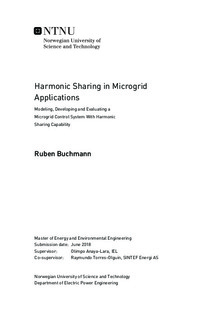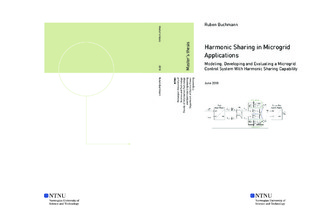| dc.description.abstract | The world is critically dependent on a transition from fossil fuels to renewable energy. Microgrids represent a promising systematic approach to increasing the reliability of the power system and solving the challenge of integrating intermittent renewable energy sources into the existing grid.
Several renewable energy sources, such as wind and photovoltaic, utilize power electronic converters, representing distinctly different characteristics compared to the technology used in the conventional power system of today. Among several traits, the converter's inherent ability to compensate harmonics is a cost-effective solution to meet the persistent challenge of harmonic distortion, which is a typical power quality issue in microgrids. However, uneven line impedances between the converters and the PCC lead to imbalance between the harmonic currents supplied by the converters, potentially harming the converter supplying most of the harmonic load.
This Master's thesis investigates a harmonic sharing scheme to meet the challenge of harmonic current sharing imbalance. A simple AC microgrid microgrid in island mode is developed, consisting of two converters, their individual LCL filters, uneven line impedances and one non-linear load. In addition, the control system of the microgrid's converters is developed and elaborated. It consists of primary control, including current, voltage and droop control, as well as control measures to achieve harmonic compensation of the capacitor voltage for both converters. This way, the issue of uneven harmonic current sharing is displayed, as the converter facing the lowest line impedance supplies the majority of the harmonic load. A virtual impedance-based harmonic sharing scheme is then implemented in the control system of the converter facing the lowest impedance, to achieve better sharing of the harmonic load. Specifically, the sharing of the 1st, 5th and 7th harmonic current component is studied.
The implemented harmonic sharing scheme is displayed with simulation results in a case study, proving the feasibility of the elaborated control system. The 5th and 7th harmonic currents are observed to be shared almost perfectly, while the fundamental component sharing is improved substantially, but still has a value of 0.033 p.u. in constant offset. Additional key performance indicators (KPIs), namely apparent power, THD and load parameters, are simultaneously monitored to give a broad assessment of the harmonic sharing scheme. In this case, all KPIs are deemed adequate, resulting in assessing the harmonic sharing scheme as successful, but with room for improvement in terms of fundamental current sharing.
Three additional cases are displayed to evaluate the control system's resilience towards certain system alterations. The first of the three additional cases investigates harmonic compensation of the PCC voltage. Isolated, the scheme is successful, as the THD of the PCC voltage is lowered from 16.2\% to 8.20\%. However, the system as a whole is not compatible with this configuration, ending in unsatisfactory performance of all other KPIs than the THD.
The second of the additional cases studies the effect of implementing opposite droop compared to a conventional droop scheme. The difference in system responses between the two implementations is observed to be marginally different, with the opposite droop delivering an improvement of fundamental harmonic current sharing. Specifically, opposite droop achieves a mismatch in fundamental current sharing of 0.013 p.u., compared to the corresponding number of 0.033 p.u. for the conventional droop.
The last of the additional cases simulates the connection of a linear load to the PCC. The harmonic sharing remains efficient, showing only a decrease in performance for the fundamental current component. However, the load experiences large ripples. E.g., the voltage has a ripple of approximately 131 V, constituting a suboptimal loading scenario. Hence, as a whole, the control system is not compatible with connecting an additional linear load between two phases.
Summarized, the harmonic sharing scheme proposed and developed demonstrates efficient harmonic sharing. However, it has been found that the proposed scheme may reduce its effectiveness when system conditions change substantially. Hence, recommendations for further work are provided which include enhancing robustness of the harmonic sharing approach. | |

